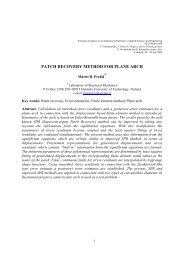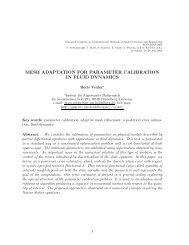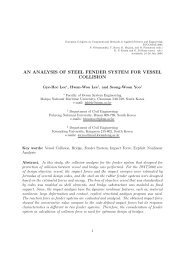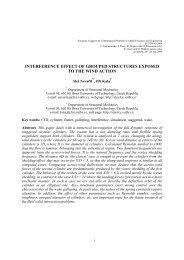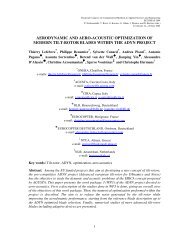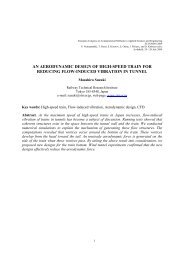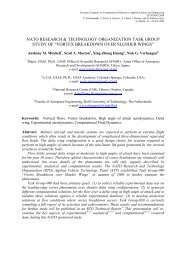Aerodynamic Design of Unmanned and Scaled Supersonic ...
Aerodynamic Design of Unmanned and Scaled Supersonic ...
Aerodynamic Design of Unmanned and Scaled Supersonic ...
You also want an ePaper? Increase the reach of your titles
YUMPU automatically turns print PDFs into web optimized ePapers that Google loves.
K. Yoshida <strong>and</strong> Y. Makino<br />
drag under the limitation <strong>of</strong> design condition <strong>and</strong> planform constraints.<br />
The key point <strong>of</strong> warp design is to suppress theoretical infinite load at leading edge. This<br />
usually leads to a certain leading edge droop to achieve an attached flow condition, because<br />
leading edge separation vortex is induced by local high angle <strong>of</strong> attack due to highly swept<br />
leading edge. This is the second principle for reducing supersonic drag.<br />
3) Area-Ruled Body<br />
According to the supersonic slender body theory [5], wave drag due to volume <strong>of</strong> a<br />
complete aircraft is generally related to so-called supersonic cross sectional area distribution.<br />
This area means the projection <strong>of</strong> oblique cross sectional area <strong>of</strong> airplane cut by Mach cone<br />
on a plane vertical to streamwise direction. The optimum axisymmetric body with the lowest<br />
wave drag due to volume was already derived using this formulation. It was called “Sears-<br />
Haack body”. If a wing <strong>and</strong> tails <strong>of</strong> a complete aircraft are specified, we suppose that fuselage<br />
geometry should be improved to adjust total supersonic area distribution to that <strong>of</strong> Sears-<br />
Haack body. It is very effective to reduce the wave drag due to total volume <strong>of</strong> the aircraft.<br />
This improved fuselage is generally called area-ruled body. This rule is the third principle <strong>of</strong><br />
reducing supersonic drag, especially interference drag between wings, tails <strong>and</strong> fuselage [5].<br />
4) Natural Laminar Flow Wing<br />
It is well expected that an aerodynamic optimum combination <strong>of</strong> the pressure drag<br />
reduction concepts mentioned above has large effect in reducing supersonic cruise drag.<br />
However, it is not easy to obtain the maximum gain <strong>of</strong> drag reduction effect, because we must<br />
consider several constraints that are not included in linear theory. Therefore, any other drag<br />
reduction concept is necessary to improve the L/D <strong>of</strong> a future advanced SST.<br />
Reducing friction drag is one <strong>of</strong> the c<strong>and</strong>idates. A laminar airfoil design concept is usually<br />
based on suppressing Tollmien-Schlichting (T-S) wave instability. For a low aspect ratio wing<br />
with highly swept leading edge, transition due to cross-flow (C-F) instability is dominant at<br />
forward part <strong>of</strong> the wing. First <strong>of</strong> all, an optimum pressure distribution must be found for<br />
suppressing the C-F instability. The key point is to reduce the region generating cross-flow.<br />
Cross-flow is produced by chordwise pressure gradient. At the front part <strong>of</strong> the wing, there is<br />
always severe acceleration. Therefore, it is very effective to set narrow acceleration region.<br />
This leads to a pressure distribution with steep gradient at front.<br />
Since the T-S instability becomes dominant after mid-chord <strong>of</strong> the wing, gradual<br />
acceleration is effective to suppress the T-S instability. Fortunately, most <strong>of</strong> SST planforms<br />
have supersonic trailing edge <strong>and</strong> require no recovery <strong>of</strong> trailing edge pressure. As a result, it<br />
was found that pressure distribution <strong>of</strong> the NLF wing had to have steep acceleration at front<br />
<strong>and</strong> gradual acceleration from the front to the trailing edge. At the first step <strong>of</strong> the NLF wing<br />
design, we already found an optimum pressure distribution to delay transition [6], using a<br />
practical transition prediction method (SALLY code [7]) based on e N method [8].<br />
As the next step, we must solve a so-called inverse design problem to achieve this pressure<br />
distribution. Therefore, we developed an original CFD-based inverse method [9]. This inverse<br />
method consists <strong>of</strong> iteration loop for the following two routines: i) flow estimation using a<br />
CFD code, <strong>and</strong> ii) modifying the geometry based on the difference between target <strong>and</strong> each<br />
5



